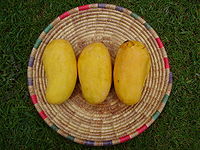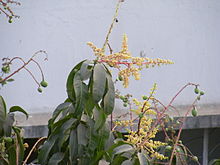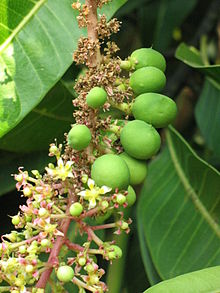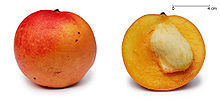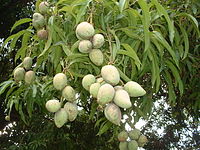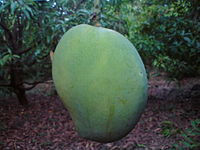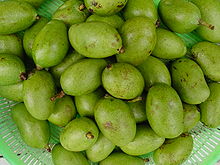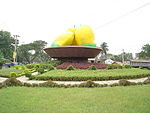- Mango
-
This article is about the fruit. For other meanings of the word, see Mango (disambiguation).Ripe Sindhri mangoes from Sindh, Pakistan

The mango is a fleshy stone fruit belonging to the genus Mangifera, consisting of numerous tropical fruiting trees in the flowering plant family Anacardiaceae. The mango is native to India from where it spread all over the world. It is also the most cultivated fruit of the tropical world. While other Mangifera species (e.g. horse mango, M. foetida) are also grown on a more localized basis, Mangifera indica – the common mango or Indian mango – is the only mango tree commonly cultivated in many tropical and subtropical regions, and its fruit is distributed essentially worldwide.
In several cultures, its fruit and leaves are ritually used as floral decorations at weddings, public celebrations and religious ceremonies[citation needed].
Contents
Etymology
The English word "mango" originated from the Tamil word "māṅgai/mankay"[1][2][3][4](Tamil: மாங்காய்) or Malayalam "māṅṅa"[5][6] (Malayalam: മാങ്ങ; from the Dravidian root word for the same), via Portuguese (also manga).[7][8] The word's first recorded attestation in a European language was a text by Ludovico di Varthema in Italian in 1510, as manga; the first recorded occurrences in languages such as French and post-classical Latin appear to be translations from this Italian text. The origin of the "-o" ending in English is unclear.[9]
When mangoes were first imported to the American colonies in the 17th century, they had to be pickled due to lack of refrigeration. Other fruits were also pickled and came to be called "mangoes" (especially bell peppers), and by the 18th century, the word "mango" became a verb meaning "to pickle".[10]
Description
Mango trees (Mangifera indica L.) grow up to 35–40 m (115–130 ft) tall, with a crown radius of 10 m (33 ft). The mango tree is long-lived, as some specimens still fruit after 300 years.[citation needed] In deep soil, the taproot descends to a depth of 6 m (20 ft) with profuse, wide-spreading feeder roots; the tree also sends down many anchor roots, which penetrate several feet of soil. The leaves are evergreen, alternate, simple, 15–35 cm (5.9–14 in) long and 6–16 cm (2.4–6.3 in) broad; when the leaves are young they are orange-pink, rapidly changing to a dark glossy red, then dark green as they mature. The flowers are produced in terminal panicles 10–40 cm (3.9–16 in) long; each flower is small and white with five petals 5–10 mm (0.20–0.39 in) long, with a mild sweet odor suggestive of lily of the valley. The fruit takes three to six months to ripen.
The ripe fruit varies in size and color. Cultivars are variously yellow, orange, red or green, and carry a single flat, oblong pit that can be fibrous or hairy on the surface, and which does not separate easily from the pulp. Ripe, unpeeled fruit gives off a distinctive resinous, sweet smell. Inside the pit 1–2 mm (0.039–0.079 in) thick is a thin lining covering a single seed, 4–7 mm (0.16–0.28 in) long. The seed contains the plant embryo.
Cultivation
Mangoes have been cultivated in South Asia for thousands of years[11] and reached East Asia between the 5th and 4th centuries BC. By the 10th century AD, cultivation had begun in East Africa.[11] The 14th century Moroccan traveler, Ibn Battuta, reported it at Mogadishu.[12] Cultivation came later to Brazil, the West Indies and Mexico, where an appropriate climate allows its growth.[11]
Mango is now cultivated in most frost-free tropical and warmer subtropical climates; More than a third of the world's mangoes are cultivated in India alone second being China[citation needed].[13][14][15]
Mango is also being grown in Andalusia, Spain (mainly in Málaga province), which is one of the few places in mainland Europe that allows growth of tropical plants and fruit trees.[16] Many of the 1,000+ mango cultivars are easily cultivated using grafted saplings, ranging from the "turpentine mango" (named for its strong taste of turpentine[17]) to the huevos de toro.[citation needed]
Other cultivators include North, South and Central America, the Caribbean, south, west and central Africa, Australia, China, Pakistan, Bangladesh, and Southeast Asia.
Though India is the largest producer of mangoes it accounts for less than one percent[citation needed] of the international mango trade, consuming most of its own output.[18]
Dwarf or semi-dwarf varieties serve as ornamental plants and can be grown in containers.
A wide variety of diseases can afflict mangoes; see List of mango diseases.
Potential for contact dermatitis
Mango peel and sap contains urushiol, the chemical in poison ivy and poison sumac that can cause urushiol-induced contact dermatitis in susceptible people.[19] Cross-reactions between mango contact allergens and urushiol have been observed.[20] Those with a history of poison ivy or poison oak contact dermatitis may be most at risk for such an allergic reaction.[21] Urushiol is also present in mango leaves and stems. During mango's primary ripening season, it is the most common source of plant dermatitis in Hawaii.[22]
Food
The mango is generally sweet, although the taste and texture of the flesh varies across cultivars, some having a soft, pulpy texture similar to an overripe plum, while the flesh of others is firmer, like a cantaloupe or avocado, or may have a fibrous texture. For consumption of unripe, pickled or cooked fruit, the mango skin may be consumed comfortably, but has potential to cause contact dermatitis of the lips, gingiva or tongue in susceptible people (see above). Under-ripe mangos can be ripened by placing them in brown paper bags. They will then keep in a plastic bag in the refrigerator for about four or five days.[23] In ripe fruits which are commonly eaten fresh, the skin may be thicker and bitter tasting, so is typically not eaten.
Cuisine
File:Mango Powder.JPGCommercially packaged mango powder sold in clear plastic wrappingMangoes are widely used in cuisine. Sour, unripe mangoes are used in chutneys, athanu, pickles, or side dishes, or may be eaten raw with salt, chili, or soy sauce. A cooling summer drink called panna or panha comes from mangoes.
Ripe mangoes are typically eaten fresh; however, they can have many other culinary uses. Mango Lassi, a popular drink made throughout South Asia[24], is created by mixing ripe mangoes or mango pulp with buttermilk and sugar. Ripe mangoes are also used to make curries. Aamras is a popular pulp/thick juice made of mangoes with sugar or milk, and is consumed with bread, rice or pooris. The pulp from ripe mangoes is also used to make jam called 'mangada'.
Mangoes are used in preserves like moramba, amchur (dried and powdered unripe mango) and pickles, including a spicy mustard-oil pickle. Ripe mangoes are often cut into thin layers, desiccated, folded, and then cut. These bars are similar to dried guava fruit bars available in some countries. The fruit is also added to cereal products like muesli and oat granola.
 A basket of ripe mangoes from Bangladesh
A basket of ripe mangoes from Bangladesh
Unripe mango may be eaten with bagoong (especially in the Philippines), fish sauce or with dash of salt. Dried strips of sweet, ripe mango (sometimes combined with seedless tamarind to form mangorind) are also popular. Mangoes may be used to make juices, mango nectar, and as a flavoring and major ingredient in ice cream and sorbetes.
Mango is used to make juices, smoothies, ice cream, fruit bars, raspados, aguas frescas, pies and sweet chili sauce, or mixed with chamoy, a sweet and spicy chili paste. It is popular on a stick dipped in hot chili powder and salt or also as a main ingredient in fresh fruit combinations. In Central America, mango is either eaten green mixed with salt, vinegar, black pepper and hot sauce, or ripe in various forms. Toasted and ground pumpkin seed (called pepita) with lime and salt are the norm when eating green mangoes. Some people also add soy sauce or chili sauce.
Pieces of mango can be mashed and used as a topping on ice cream or blended with milk and ice as milkshakes. Sweet glutinous rice is flavored with coconut, then served with sliced mango as a dessert. In other parts of Southeast Asia, mangoes are pickled with fish sauce and rice vinegar. Green mangoes can be used in mango salad with fish sauce and dried shrimp. Mango with condensed milk may be used as a topping for shaved ice.
Nutrients and phytochemicals
Mango, raw Nutritional value per 100 g (3.5 oz) Energy 272 kJ (65 kcal) Carbohydrates 17.00 g - Sugars 14.8 g - Dietary fiber 1.8 g Fat 0.27 g Protein 0.51 g Vitamin A equiv. 38 μg (5%) - beta-carotene 445 μg (4%) Thiamine (vit. B1) 0.058 mg (5%) Riboflavin (vit. B2) 0.057 mg (5%) Niacin (vit. B3) 0.584 mg (4%) Pantothenic acid (B5) 0.160 mg (3%) Vitamin B6 0.134 mg (10%) Folate (vit. B9) 14 μg (4%) Vitamin C 27.7 mg (33%) Calcium 10 mg (1%) Iron 0.13 mg (1%) Magnesium 9 mg (3%) Phosphorus 11 mg (2%) Potassium 156 mg (3%) Zinc 0.04 mg (0%) Percentages are relative to US recommendations for adults.
Source: USDA Nutrient DatabaseNutritional value per 100 g (3.5 oz) is 272 kJ (65 kcal) and that of the apple mango is slightly higher (79 kcal per 100g). Mango is rich in a variety of phytochemicals[25] and nutrients. The fruit pulp is high in prebiotic dietary fiber, vitamin C, diverse polyphenols and provitamin A carotenoids.[26]
Mango contains essential vitamins and dietary minerals. The antioxidant vitamins A, C and E compose 25%, 76% and 9% of the Dietary Reference Intake (DRI) in a 165-gram (5.8-oz) serving. Vitamin B6 (pyridoxine, 11% DRI), vitamin K (9% DRI), other B vitamins and essential nutrients, such as potassium, copper and 17 amino acids are at good levels. Mango peel and pulp contain other phytonutrients, such as the pigment antioxidants – carotenoids and polyphenols – and omega-3 and -6 polyunsaturated fatty acids.[citation needed]
Mango peel contains pigments that may have antioxidant properties,[25][27] including carotenoids, such as the provitamin A compound, beta-carotene, lutein and alpha-carotene,[28] polyphenols[29][30] such as quercetin, kaempferol, gallic acid, caffeic acid, catechins, tannins, and the unique mango xanthonoid, mangiferin,[31] any of which may counteract free radicals in various disease processes as revealed in preliminary research.[32][33] Phytochemical and nutrient content appears to vary across mango species.[34] Up to 25 different carotenoids have been isolated from mango pulp, the densest of which was beta-carotene, which accounts for the yellow-orange pigmentation of most mango species.[35] Peel and leaves also have significant polyphenol content, including xanthonoids, mangiferin and gallic acid.[36]
The mango triterpene, lupeol,[37] is an effective inhibitor in laboratory models of prostate and skin cancers.[38][39][40] An extract of mango branch bark called Vimang, isolated by Cuban scientists, contains numerous polyphenols with antioxidant properties in vitro[41] and on blood parameters of elderly humans.[42]
The pigment euxanthin, known as Indian yellow, is often thought to be produced from the urine of cattle fed mango leaves; the practice is described as having been outlawed in 1908 due to malnutrition of the cows and possible urushiol poisoning.[43] This supposed origin of euxanthin appears to rely on a single, anecdotal source, and Indian legal records do not outlaw such a practice.[44]
Cultural significance
Mango roundabout, Rajshahi, Bangladesh
The mango is the national fruit of India,[45] Pakistan, and the Philippines.[46] The mango tree is the national tree of Bangladesh.[47]
In Hinduism, the perfectly ripe mango is often held by Lord Ganesha as a symbol of attainment, regarding the devotees potential perfection. Mango blossoms are also used in the worship of the goddess Saraswati.
Mango leaves are used to decorate archways and doors in Indian houses and during weddings and celebrations like Ganesh Chaturthi. Mango motifs and paisleys are widely used in different Indian embroidery styles, and are found in Kashmiri shawls, Kanchipuram silk sarees, etc. Paisleys are also common to Iranian art, because of its pre-Islamic Zoroastrian past.
In Tamil Nadu, the mango is considered, along with banana and jackfruit, as one of the three royal fruits (Mukkani)
Famous Urdu poet Mirza Asadullah Khan Ghalib was very fond of mangoes. There are many anecdotes concerning his love for mangoes.
In Australia, where mangoes are considered to be a symbol of summer, the first tray of mangoes of the season is traditionally sold at an auction for charity.[48]Production and consumption
Mangoes account for approximately half of all tropical fruits produced worldwide. The Food and Agriculture Organization of the United Nations estimates worldwide production at nearly 35,000,000 tonnes (39,000,000 short tons) in 2009 (table below). The aggregate production of the top 10 countries is responsible for roughly 80% of worldwide production.
Alphonso, Benishaan or Benisha (Banginapalli in Telugu and other south Indian languages) and Kesar mango varieties are considered[by whom?] among the best mangoes in India's southern states, while Chausa, Dasheri and Langra varieties are most popular in the northern states.
Generally, ripe mangoes have an orange-yellow or reddish peel and are juicy for eating, while exported fruit are often picked while underripe with green peels. Although producing ethylene while ripening, unripened exported mangoes do not have the same juiciness or flavor as fresh fruit.
Like other drupaceous fruits, mangoes come in both freestone and clingstone varieties.
Top producers of mangoes, mangosteens, guavas, 2008-9 Country Production in millions of tons  India
India~ 13.6  People's Republic of China
People's Republic of China4.2  Thailand
Thailand2.5  Indonesia
Indonesia2.2  Mexico
Mexico~ 1.9  Pakistan
Pakistan~ 1.8  Brazil
Brazil~ 1.2 World total 34.9 Key ~ 2008 data
Cultivars
Main article: List of mango cultivars Alphonso mangoes (local name: Hapoos) are grown mainly in Devgad, Sindhudurg and Ratnagiri districts of Maharashtra and Valsad district of Gujarat, India, and favored there, and are now popular in the United States.[49][50]
Alphonso mangoes (local name: Hapoos) are grown mainly in Devgad, Sindhudurg and Ratnagiri districts of Maharashtra and Valsad district of Gujarat, India, and favored there, and are now popular in the United States.[49][50]
Many hundreds of named mango cultivars exist. In mango orchards, several cultivars are often crossed to improve pollination. Many desired cultivars are monoembryonic and must be propagated by grafting or they do not breed true. A common mono-embryonic cultivar is Alphonso, an important export product.
Cultivars that excel in one climate may fail elsewhere. For example, Indian cultivars such as Julie, a prolific cultivar in Jamaica, require annual fungicide treatment to escape a lethal fungal disease known as anthracnose in Florida. Asian mangoes are resistant to anthracnose.
The current world market is dominated by the cultivar Tommy Atkins, a seedling of Haden that first fruited in 1940 in southern Florida, U.S. It was initially rejected commercially by Florida researchers.[51] For example, 80% of mangoes in UK supermarkets are Tommy Atkins. Despite its fibrous flesh and only fair taste, growers worldwide have embraced the cultivar for its exceptional productivity and disease resistance, shelf-life, transportability and size and appealing color. Tommy Atkins is predominant in the U.S. as well, although other cultivars, such Kent, Keitt, the Haitian-grown Madame Francis and the Mexican grown Champagne are widely available.
In urban areas of southern Florida, small gardens have fueled the desire for dwarf mango trees. The Fairchild Tropical Botanic Garden has promoted "condo mangoes," such as Fairchild, which produces at a height below 2–2.5 m (6.6–8.2 ft).[citation needed]
Condo mango is a term that became popular some years ago in Florida, U.S., and the word "condo" is derived from the word condominium because a condo mango tree, being dwarfed and small in size, was suitable for container growing in condominiums. Essentially, "condo" means a smaller variety of tree that is dwarf or semidwarf in nature, e.g. Ice Cream, or grafted to achieve a dwarfing characteristic, that can be maintained to a certain size with careful foliage pruning and root pruning if necessary. While condo has been generally associated with mango trees, it can be applied to any fruit tree that is a natural dwarf or has been dwarfed similar to the bonsai technique. As such, the words "condo" and "dwarf" are interchangeable.
There is an Australian variety of mango known as R2E2, a name based on the original plant's orchard row location. This variety produces large (up to 1 kg or 2 lb) yellow-red fruit that attracts a premium price in the Australian market.
Evolution
See also: Avocado#Co-evolutionSee also
- Chok anan (honey mango)
- Mango oil
- Recalcitrant seed
Gallery
References
- ^ [1]
- ^ http://books.google.com/books?id=u2oPAAAAYAAJ&q=mango+tamil+etymology&dq=mango+tamil+etymology&hl=en&ei=77pPTojFFoOGrAfUpN2sAg&sa=X&oi=book_result&ct=result&resnum=3&ved=0CDUQ6AEwAjgK
- ^ http://dictionary.reference.com/browse/mango
- ^ http://www.britannica.com/EBchecked/topic/362003/mango
- ^ Mango Merriam Webster Dictionary.
"Origin of mango: Portuguese manga, probably from Malayalam māṅṅa. First Known Use: 1582" - ^ http://oxforddictionaries.com/definition/mango
- ^ Mango Merriam Webster Dictionary.
"Origin of mango: Portuguese manga, probably from Malayalam māṅṅa. First Known Use: 1582" - ^ http://oxforddictionaries.com/definition/mango
- ^ OED Online entry mango, n. 1. (Draft revision Sept. 2010, retrieved 13/10/2010)
- ^ Creed, Richard (2010-09-05). "Relative Obscurity: Variations of antigodlin grow". Winston-Salem Journal. http://www2.journalnow.com/content/2010/sep/05/032140/relative-obscurity-variations-of-antigodlin-grow/. Retrieved 2010-09-06.[dead link]
- ^ a b c Ensminger 1994: 1373
- ^ Watson, Andrew J. (1983). Agricultural innovation in the early Islamic world: the diffusion of crops and farming techniques, 700–1100. Cambridge, UK: Cambridge University Press. pp. 72–3. ISBN 0-521-24711-X.
- ^ Jedele S, Hau AM, von Oppen M. An analysis of the world market for mangoes and its importance for developing countries. Conference on International Agricultural Research for Development, 2003 [2]
- ^ India world's largest producer of mangoes, Rediff India Abroad, April 21, 2004
- ^ Mad About mangoes: As exports to the U.S. resume, a juicy business opportunity ripens, India Knowledge@Wharton Network, June 14, 2007
- ^ actahort.org
- ^ According to the 'Oxford Companion to Food'
- ^ USAID helps Indian mango farmers access new markets, USAID-India, May 3, 2006
- ^ Rocha Ribeiro SM, Queiroz JH, Lopes Ribeiro de Queiroz ME, Campos FM, Pinheiro Sant'ana HM (2007). "Antioxidant in mango (Mangifera indica L.) pulp". Plant Foods Hum Nutr 62 (1): 13–7. doi:10.1007/s11130-006-0035-3. PMID 17243011. "However, the mango peel has properties similar to sumac or poison ivy, resulting in allergic rashes around the mouth, eyes, cheeks, and genitalia if the urushiol oil is spread. Washing the affected area within five minutes after contact should prevent some of the symptoms. Symptoms can be swelling, formation of yellow sores, redness, and, if unmaintained, may be subjected to bacterial infection."
- ^ Oka K, Saito F, Yasuhara T, Sugimoto A. (2004). "A study of cross-reactions between mango contact allergens and urushiol". Contact Dermatitis 51 (5–6): 292–6. doi:10.1111/j.0105-1873.2004.00451.x. PMID 15606656.
- ^ Hershko K, Weinberg I, Ingber A (2005). "Exploring the mango – poison ivy connection: the riddle of discriminative plant dermatitis". Contact Dermatitis 52 (1): 3–5. doi:10.1111/j.0105-1873.2005.00454.x. PMID 15701120.
- ^ McGovern TW, LaWarre S (2001). "Botanical briefs: the mango tree—Mangifera indica L.". Cutis 67 (5): 365–6.
- ^ "Ingredients - Mangoes". DrGourmet.com. http://www.drgourmet.com/ingredients/mangos.shtml. Retrieved 2011-07-20.
- ^ [3] Vah Chef talking about Mango Lassi's popularity and showing how to make the drink.
- ^ a b Ajila CM, Prasada Rao UJ (2008). "Protection against hydrogen peroxide induced oxidative damage in rat erythrocytes by Mangifera indica L. peel extract". Food Chem Toxicol 46 (1): 303–9. doi:10.1016/j.fct.2007.08.024. PMID 17919803.
- ^ Nutrient profile for mango, Nutritiondata.com
- ^ Berardini N, Fezer R, Conrad J, Beifuss U, Carle R, Schieber A (2005). "Screening of mango (Mangifera indica L.) cultivars for their contents of flavonol O – and xanthone C-glycosides, anthocyanins, and pectin". J Agric Food Chem 53 (5): 1563–70. doi:10.1021/jf0484069. PMID 15740041.
- ^ Gouado I, Schweigert FJ, Ejoh RA, Tchouanguep MF, Camp JV (2007). "Systemic levels of carotenoids from mangoes and papaya consumed in three forms (juice, fresh and dry slice)". Eur J Clin Nutr 61 (10): 1180–8. doi:10.1038/sj.ejcn.1602841. PMID 17637601.
- ^ Mahattanatawee K, Manthey JA, Luzio G, Talcott ST, Goodner K, Baldwin EA (2006). "Total antioxidant activity and fiber content of select Florida-grown tropical fruits". J Agric Food Chem 54 (19): 7355–63. doi:10.1021/jf060566s. PMID 16968105.
- ^ Singh UP, Singh DP, Singh M, et al. (2004). "Characterization of phenolic compounds in some Indian mango cultivars". Int J Food Sci Nutr 55 (2): 163–9. doi:10.1080/09637480410001666441. PMID 14985189.
- ^ Andreu GL, Delgado R, Velho JA, Curti C, Vercesi AE (2005). "Mangiferin, a natural occurring glucosyl xanthone, increases susceptibility of rat liver mitochondria to calcium-induced permeability transition". Arch Biochem Biophys 439 (2): 184–93. doi:10.1016/j.abb.2005.05.015. PMID 15979560.
- ^ Percival SS, Talcott ST, Chin ST, Mallak AC, Lounds-Singleton A, Pettit-Moore J (2006). "Neoplastic transformation of BALB/3T3 cells and cell cycle of HL-60 cells are inhibited by mango (Mangifera indica L.) juice and mango juice extracts". J Nutr 136 (5): 1300–4. PMID 16614420. http://jn.nutrition.org/cgi/pmidlookup?view=long&pmid=16614420.
- ^ Rodríguez J, Di Pierro D, Gioia M, et al. (2006). "Effects of a natural extract from Mangifera indica L, and its active compound, mangiferin, on energy state and lipid peroxidation of red blood cells". Biochim Biophys Acta 1760 (9): 1333–42. doi:10.1016/j.bbagen.2006.04.005. PMID 16860486.
- ^ Rocha Ribeiro SM, Queiroz JH, Lopes Ribeiro de Queiroz ME, Campos FM, Pinheiro Sant'ana HM (2007). "Antioxidant in mango (Mangifera indica L.) pulp". Plant Foods Hum Nutr 62 (1): 13–7. doi:10.1007/s11130-006-0035-3. PMID 17243011.
- ^ Chen JP, Tai CY, Chen BH (2004). "Improved liquid chromatographic method for determination of carotenoids in Taiwanese mango (Mangifera indica L.)". J Chromatogr A 1054 (1–2): 261–8. PMID 15553152.
- ^ Barreto JC, Trevisan MT, Hull WE, et al. (2008). "Characterization and quantitation of polyphenolic compounds in bark, kernel, leaves, and peel of mango (Mangifera indica L.)". J Agric Food Chem 56 (14): 5599–610. doi:10.1021/jf800738r. PMID 18558692.
- ^ Chaturvedi PK, Bhui K, Shukla Y (2008). "Lupeol: connotations for chemoprevention". Cancer Lett 263 (1): 1–13. doi:10.1016/j.canlet.2008.01.047. PMID 18359153.
- ^ Prasad S, Kalra N, Singh M, Shukla Y (2008). "Protective effects of lupeol and mango extract against androgen induced oxidative stress in Swiss albino mice" (PDF). Asian J Androl 10 (2): 313–8. doi:10.1111/j.1745-7262.2008.00313.x. PMID 18097535. http://www.nature.com/aja/journal/v10/n2/pdf/aja2008241a.pdf.
- ^ Nigam N, Prasad S, Shukla Y (2007). "Preventive effects of lupeol on DMBA induced DNA alkylation damage in mouse skin". Food Chem Toxicol 45 (11): 2331–5. doi:10.1016/j.fct.2007.06.002. PMID 17637493.
- ^ Saleem M, Afaq F, Adhami VM, Mukhtar H (2004). "Lupeol modulates NF-kappaB and PI3K/Akt pathways and inhibits skin cancer in CD-1 mice". Oncogene 23 (30): 5203–14. doi:10.1038/sj.onc.1207641. PMID 15122342.
- ^ Rodeiro I, Cancino L, González JE, et al. (2006). "Evaluation of the genotoxic potential of Mangifera indica L. extract (Vimang), a new natural product with antioxidant activity". Food Chem Toxicol 44 (10): 1707–13. doi:10.1016/j.fct.2006.05.009. PMID 16857303.
- ^ Pardo-Andreu GL, Philip SJ, Riaño A, et al. (2006). "Mangifera indica L. (Vimang) protection against serum oxidative stress in elderly humans". Arch Med Res 37 (1): 158–64. doi:10.1016/j.arcmed.2005.04.017. PMID 16314203.
- ^ History of Indian yellow, Pigments Through the Ages
- ^ Finlay, Victoria (2003). Color: A Natural History of the Palette. New York: Random House Trade Paperbacks. ISBN 0-8129-7142-6.
- ^ "National Fruit". Know India. Government of India. http://india.gov.in/knowindia/national_fruit.php. Retrieved 2010-08-17.
- ^ "Philippine National Symbols or Mga Pambansang Sagisag Ng Pilipinas". www.philippinecountry.com. http://www.philippinecountry.com/philippine_national_symbols.html. Retrieved 2010-11-22.
- ^ "Mango tree, national tree". BDnews24.com. http://bdnews24.com/details.php?id=179003&cid=2. Retrieved 2010-11-16.
- ^ First tray of mangoes sells for $30,000, Australian Associated Press via The Sydney Morning Herald, September 8, 2010.
- ^ Allen J. Mango mania in Portland, Oregon, New York Times, May 10, 2006
- ^ Black R. Plump it up. Sweet, juicy mangoes are at their peak, with seasonal varieties ripe for the picking, New York Daily News, May 13, 2007
- ^ Susser, Allen (2001). The Great Mango Book. New York: Ten Speed Press. ISBN 1580082041.
Further reading
- Books
- Ensminger, Audrey H.; et al. (1995). The Concise Encyclopedia of Foods & Nutrition. CRC Press. p. 651. ISBN 0849344557.
- Litz, Richard E. (editor, 2009). The Mango: Botany, Production and Uses. 2nd edition. CABI. ISBN 9781845934897
- Susser, Allen (2001). The Great Mango Book: A Guide with Recipes. Ten Speed Press. ISBN 9781580082044
External links
- Common Mango
- Mango
- Mango Nutrition Information from USDA SR 22 database
- Mango-related dermatitis
- Sorting Mangifera species
- Tropical fruits: Mango
Mangoes List Mango cultivars Aamras • Alampur Baneshan • Alice • Alphonso • Anderson • Angie • Ataulfo • Bailey's Marvel • Bennet Alphonso • Beverly • Bombay • Brahm Kai Meu • Brooks • Carrie • Cecil • Chaunsa • Chok anan • Cogshall • Cushman • Dasheri • Dot • Duncan • Earlygold • Edward • Eldon • Emerald • Fairchild • Fascell • Florigon • Ford • Gary • Glenn • Golden Lippens • Gold Nugget • Graham • Haden • Hatcher • Ice Cream • Irwin • Jakarta • Jean Ellen • Julie • Keitt • Kensington Pride • Kent • Lancetilla • Langra • Lippens • Maha Chanook • Mallika • Manilita • Mulgoba • Nam Doc Mai • Osteen • Palmer • Parvin • Pickering • Rosigold • Ruby • Saigon • Sammar Bahisht • Sensation • Shan-e-Khuda • Sophie Fry • Southern Blush • Spirit of '76 • Springfels • Sunset • Tebow • Timotayo • Tommy Atkins • Torbert • Valencia Pride • Van Dyke • Young • ZillOther topics National symbols of the Philippines Official Unofficial National heroes: José Rizal, Andrés Bonifacio, Emilio Aguinaldo, Apolinario Mabini, Marcelo H. del Pilar, Sultan Dipatuan Kudarat, Juan Luna, Melchora Aquino, and Gabriela Silang · Cariñosa · Carabao · Bangus · "Bayan Ko" · "Pilipinas Kong Mahal" · Juan de la Cruz · Anahaw · Mango · Sipa · Barong and Baro't sayaCategories:- Mangoes
- Flora of Florida
- Flora of India
- Fruits originating in Asia
- Medicinal plants
- Vietnamese ingredients
- Puerto Rican ingredients
Wikimedia Foundation. 2010.


